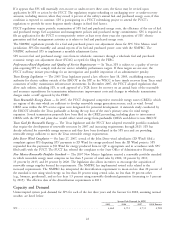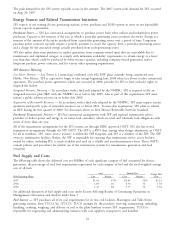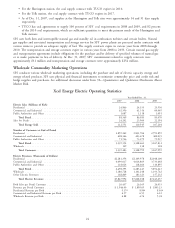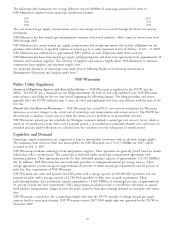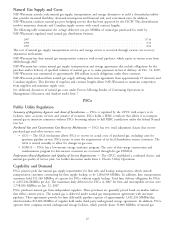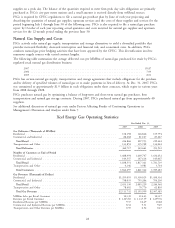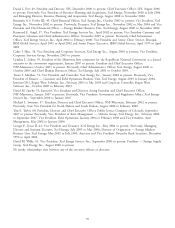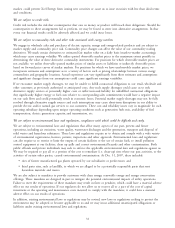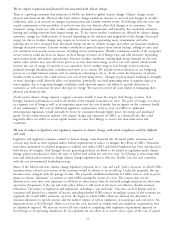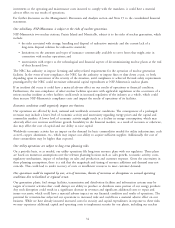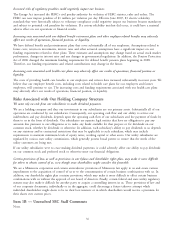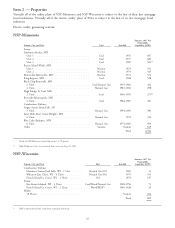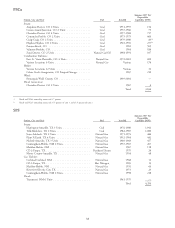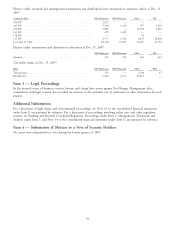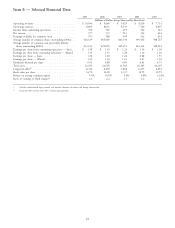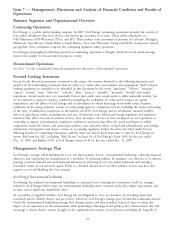Xcel Energy 2007 Annual Report Download - page 42
Download and view the complete annual report
Please find page 42 of the 2007 Xcel Energy annual report below. You can navigate through the pages in the report by either clicking on the pages listed below, or by using the keyword search tool below to find specific information within the annual report.market, could prevent Xcel Energy from issuing new securities or cause us to issue securities with less than ideal terms
and conditions.
We are subject to credit risks.
Credit risk includes the risk that counterparties that owe us money or product will breach their obligations. Should the
counterparties to these arrangements fail to perform, we may be forced to enter into alternative arrangements. In that
event, our financial results could be adversely affected and we could incur losses.
We are subject to commodity risks and other risks associated with energy markets.
We engage in wholesale sales and purchases of electric capacity, energy and energy-related products and are subject to
market supply and commodity price risk. Commodity price changes can affect the value of our commodity trading
derivatives. We mark certain derivatives to estimated fair market value on a daily basis (mark-to-market accounting),
which may cause earnings volatility. We utilize quoted observable market prices to the maximum extent possible in
determining the value of these derivative commodity instruments. For positions for which observable market prices are
not available, we utilize observable quoted market prices of similar assets or liabilities or indirectly observable prices
based on forward price curves of similar markets. For positions for which we have unobservable market prices, we
incorporate estimates and assumptions as to a variety of factors such as pricing relationships between various energy
commodities and geographic locations. Actual experience can vary significantly from these estimates and assumptions
and significant changes from our assumptions could cause significant earnings variability.
If we encounter market supply shortages, we may be unable to fulfill contractual obligations to our retail, wholesale and
other customers at previously authorized or anticipated costs. Any such supply shortages could cause us to seek
alternative supply services at potentially higher costs or suffer increased liability for unfulfilled contractual obligations.
Any significantly higher energy or fuel costs relative to corresponding sales commitments would have a negative impact
on our cash flows and could potentially result in economic losses. Potential market supply shortages may not be fully
resolved through alternative supply sources and such interruptions may cause short-term disruptions in our ability to
provide electric and/or natural gas services to our customers. These cost and reliability issues vary in magnitude for each
operating subsidiary depending upon unique operating conditions such as generation fuels mix, availability of fuel
transportation, electric generation capacity, and transmission, etc.
We are subject to environmental laws and regulations, compliance with which could be difficult and costly.
We are subject to environmental laws and regulations that affect many aspects of our past, present and future
operations, including air emissions, water quality, wastewater discharges and the generation, transport and disposal of
solid wastes and hazardous substances. These laws and regulations require us to obtain and comply with a wide variety
of environmental registrations, licenses, permits, inspections and other approvals. Environmental laws and regulations
can also require us to restrict or limit the output of certain facilities or the use of certain fuels, to install pollution
control equipment at our facilities, clean up spills and correct environmental hazards and other contamination. Both
public officials and private individuals may seek to enforce the applicable environmental laws and regulations against us.
We may be required to pay all or a portion of the cost to remediate (i.e. clean-up) sites where our past activities, or the
activities of certain other parties, caused environmental contamination. At Dec. 31, 2007, these included:
• sites of former manufactured gas plants operated by our subsidiaries or predecessors; and
• third party sites, such as landfills, to which we are alleged to be a potentially responsible party that sent
hazardous materials and wastes.
We are also subject to mandates to provide customers with clean energy, renewable energy and energy conservation
offerings. These mandates are designed in part to mitigate the potential environmental impacts of utility operations.
Failure to meet the requirements of these mandates may result in fines or penalties, which could have a material adverse
effect on our results of operations. If our regulators do not allow us to recover all or a part of the cost of capital
investment or the operating and maintenance costs incurred to comply with the mandates, it could have a material
adverse effect on our results of operations.
In addition, existing environmental laws or regulations may be revised, new laws or regulations seeking to protect the
environment may be adopted or become applicable to us and we may incur additional unanticipated obligations or
liabilities under existing environmental laws and regulations.
32


